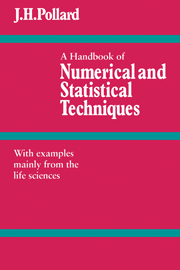Book contents
- Frontmatter
- Contents
- List of statistical and mathematical tables
- Preface
- PART I BASIC NUMERICAL TECHNIQUES
- 1 Introduction
- 2 Errors, mistakes and the arrangement of work
- 3 The real roots of non-linear equations
- 4 Simple methods for smoothing crude data
- 5 The area under a curve
- 6 Finite differences, interpolation and numerical differentiation
- 7 Some other numerical techniques
- PART II BASIC STATISTICAL TECHNIQUES
- PART III THE METHOD OF LEAST SQUARES
- Appendix
- References
- Author index
- Subject index
3 - The real roots of non-linear equations
Published online by Cambridge University Press: 18 December 2009
- Frontmatter
- Contents
- List of statistical and mathematical tables
- Preface
- PART I BASIC NUMERICAL TECHNIQUES
- 1 Introduction
- 2 Errors, mistakes and the arrangement of work
- 3 The real roots of non-linear equations
- 4 Simple methods for smoothing crude data
- 5 The area under a curve
- 6 Finite differences, interpolation and numerical differentiation
- 7 Some other numerical techniques
- PART II BASIC STATISTICAL TECHNIQUES
- PART III THE METHOD OF LEAST SQUARES
- Appendix
- References
- Author index
- Subject index
Summary
Summary In this chapter we describe several different methods for finding the real roots of non-linear equations. Each has its own advantages and disadvantages. The method of false position (section 3.2) is the only one which always converges. The Newton-Raphson method of section 3.6 for solving two simultaneous non-linear equations can be generalised to three or more variables.
Introduction
Non-linear equations often arise in scientific work. Graphical methods may be used to solve these equations, but the order of accuracy is usually such that the answer obtained can only be regarded as a first approximation. Trialand-error methods can also be used. Iterative methods are usually most convenient. These are procedures whereby xn the nth approximation to the root is obtained by evaluating a function of the earlier approximation xn–1.
The iterative procedures described in this chapter are usually quite satisfactory, but the reader is warned that they may fail in certain circumstances; for example, with multiple roots and close roots. The practical research worker will try a reasonable method. If this fails, he will try another method. If this also fails, he may be advised to seek the assistance of a numerical analyst.
Further reading; Conte [17] 19–70; Fröberg [28] 17–26; Hartree [41] 190–7; Hildebrand [43] 443; Nielsen [73] 169–223; Sokolnikoff and Sokolnikoff [92] 95–6.
The method of false position
Let us imagine that we wish to solve the non-linear equation f(x) = 0 and we have found that f(a) is positive whilst f(b) is negative.
- Type
- Chapter
- Information
- A Handbook of Numerical and Statistical TechniquesWith Examples Mainly from the Life Sciences, pp. 18 - 25Publisher: Cambridge University PressPrint publication year: 1977
- 1
- Cited by



